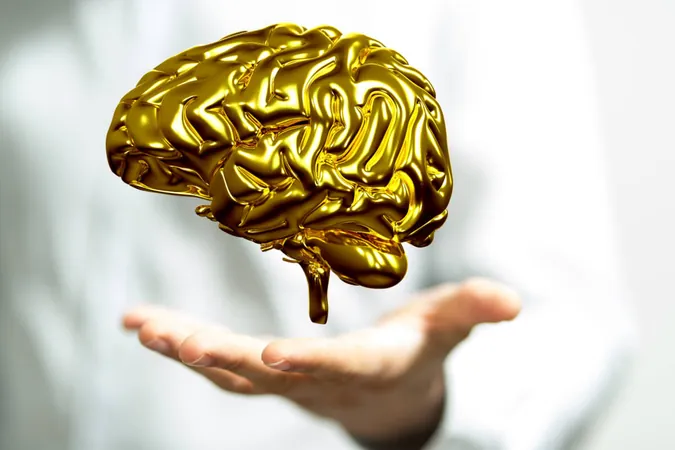
Unmasking the Brain's Aging Process: A Revolutionary Study Reveals Startling Insights
2025-01-25
Author: Ming
Introduction
In an unprecedented breakthrough, researchers at the Allen Institute have pinpointed where aging first manifests in the brain, unveiling the initial signs of cognitive decline. This groundbreaking study, published in the prestigious journal Nature, details the creation of the first comprehensive cellular atlas of brain aging by meticulously analyzing millions of individual cells in a mouse model.
Understanding Brain Aging
Imagine the brain as a sprawling metropolis, divided into countless distinct neighborhoods, each home to specialized cell types performing crucial functions. Until now, scientists struggled to understand how these neighborhoods evolve as the brain ages. This landmark study provides clarity, assessing cells from both young adult mice (around 2 months) and aged mice (approximately 18 months). Although mice age more rapidly than humans, these findings have profound implications for understanding human brain aging.
Key Findings
The research examined 16 different brain regions, covering about 35% of the entire mouse brain's volume, and identified an astonishing 847 distinct cell types. Among these, support cells known as glia emerged as particularly sensitive to the aging process. Notably, significant alterations were detected around a region called the third ventricle in the hypothalamus, a critical area that regulates vital functions such as hunger, body temperature, sleep, and hormonal balance.
Immune Activity and Aging
As the brain ages, increased immune activity was observed across various cell types, particularly in microglia—specialized cells responsible for the brain's maintenance and immune defenses. These microglia and border-associated macrophages exhibited heightened inflammatory activity in older mice, indicating a vigorous effort to preserve neurological health.
Alterations in Specialized Cells
Fascinating alterations were also uncovered in specialized cells called tanycytes and ependymal cells, which line the brain's fluid-filled cavities, particularly around the vital third ventricle. Kelly Jin, Ph.D., the lead researcher, hypothesizes that these cell types may be becoming less effective at processing environmental and dietary signals, which might exacerbate aging effects throughout the entire body.
Impact on Myelin and Nerve Communication
The research further uncovered that cells producing myelin—the insulating material essential for efficient nerve communication—were negatively affected by aging. Myelin acts like insulation around electrical wires, safeguarding the communication pathways between neurons. Disruptions to this crucial layer could lead to impaired brain circuit functionality.
Hypothalamic Neurons and Aging
Moreover, the study identified specific hypothalamic neurons that crucially regulate appetite, metabolism, and energy expenditure, which displayed alarming signs of both decreased function and elevated immune activity with age. This finding reinforces previous research suggesting that dietary interventions, such as intermittent fasting and calorie restriction, may significantly impact longevity.
Significance of the Research
Dr. Richard J. Hodes, the director of the NIH’s National Institute on Aging, emphasizes the significance of these findings: "Aging is the most critical risk factor for Alzheimer’s disease and numerous other debilitating brain disorders. This research presents a meticulously detailed map identifying which brain cells are most susceptible to the effects of aging."
Conclusion
As scientists continue to decode the complexities of the aging brain, this remarkable work opens new avenues for understanding the mechanisms behind cognitive decline and may pave the way for novel therapeutic strategies aimed at extending brain health in aging populations. Could this research hold the key to unlocking the secrets of longevity? Only time will tell.


 Brasil (PT)
Brasil (PT)
 Canada (EN)
Canada (EN)
 Chile (ES)
Chile (ES)
 Česko (CS)
Česko (CS)
 대한민국 (KO)
대한민국 (KO)
 España (ES)
España (ES)
 France (FR)
France (FR)
 Hong Kong (EN)
Hong Kong (EN)
 Italia (IT)
Italia (IT)
 日本 (JA)
日本 (JA)
 Magyarország (HU)
Magyarország (HU)
 Norge (NO)
Norge (NO)
 Polska (PL)
Polska (PL)
 Schweiz (DE)
Schweiz (DE)
 Singapore (EN)
Singapore (EN)
 Sverige (SV)
Sverige (SV)
 Suomi (FI)
Suomi (FI)
 Türkiye (TR)
Türkiye (TR)
 الإمارات العربية المتحدة (AR)
الإمارات العربية المتحدة (AR)